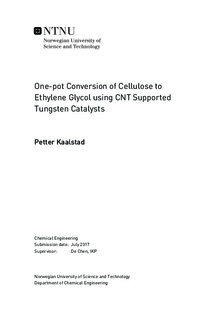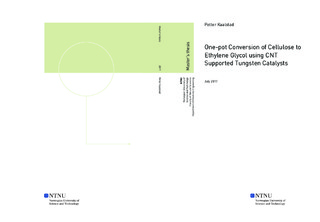| dc.description.abstract | The one-pot catalytic conversion of cellulose to ethylene glycol (EG) is a promising approach for biomass utilization. The catalysts developed for this process have to be bifunctional, catalysing both retro-aldol condensation and hydrogenation. In this study, various tungsten-based catalysts (mostly WO3/CNT and W2C/CNT) were tested for their retro-aldol condensation activity alone and with the addition of copper (Cu) to examine the promotion effect of Cu on the hydrogenation activity. The nominal loading of each catalyst was typically 10 wt% W and 10 wt% Cu, which were tested at 245 °C and 60 bar H2 for 90/180 minutes in a batch reactor with cellulose as the feedstock. From these results it was evident that copper did exhibit a promotional effect on the hydrogenation activity, but the hydrogenation of copper was very low with a maximum EG and 1,2-PG yield of 7.7% and 3.5%, respectively, after 180 minutes with W2C-Cu/CNT. The low yields were a result of the insufficient hydrogenation activity of copper, resulting in a large amount of unsaturated by-products.
The WO3/CNT and W2C/CNT catalysts were also tested in combination with CuxO/CNT and Ru/CNT in order to assess the hydrogenation ability of Cu and Ru. When tested in combination with CuxO/CNT (Cu/W ratio = 1.0) the EG and 1,2-PG yield was higher than without the presence of Cu, but the EG yield was lower than the tungsten-copper catalysts. The Cu/W ratio was therefore too low to allow for sufficient hydrogenation. When tested in combination with Ru/CNT (Ru/W = 0.1), the hydrogenation activity was significantly increased, producing a maximum of 30.5% EG and 12.3% 1,2-PG with 10 wt% WO3/CNT + Ru/CNT. The W2C/CNT + Ru/CNT resulted in lower EG and 1,2-PG yields and higher glycerol, sorbitol, and mannitol yields due to the combined hydrogenation by both W2C and Ru. The Ru/W ratio is therefore too high with W2C/CNT, but may be increased with WO3/CNT. The use of WO3/CNT with both copper and ruthenium resulted in less side products being formed, and in the case of Ru, inhibited the HMF degradation pathway entirely. This shows promising uses for WO3 as a catalyst as the EG selectivity and yield may be greatly enhanced. | |

